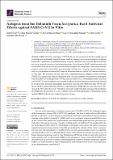Por favor, use este identificador para citar o enlazar a este item:
http://hdl.handle.net/10261/332443COMPARTIR / EXPORTAR:
 SHARE SHARE
 CORE
BASE CORE
BASE
|
|
| Visualizar otros formatos: MARC | Dublin Core | RDF | ORE | MODS | METS | DIDL | DATACITE | |

| Título: | Antigens from the helminth Fasciola hepatica exert antiviral effects against SARS-CoV-2 in vitro |
Autor: | Serrat, Judit CSIC ORCID; Francés-Gómez, Clara CSIC ORCID; Becerro Recio, David CSIC ORCID; González Miguel, Javier CSIC ORCID ; Geller, Ron CSIC ORCID ; Siles Lucas, Mar CSIC ORCID | Palabras clave: | COVID-19 Fasciola hepatica SARS-CoV-2 Antiviral Helminths In vitro |
Fecha de publicación: | 2023 | Editor: | Multidisciplinary Digital Publishing Institute | Citación: | International Journal of Molecular Sciences 24(14): 11597 (2023) | Resumen: | SARS-CoV-2, the causal agent of COVID-19, is a new coronavirus that has rapidly spread worldwide and significantly impacted human health by causing a severe acute respiratory syndrome boosted by a pulmonary hyperinflammatory response. Previous data from our lab showed that the newly excysted juveniles of the helminth parasite Fasciola hepatica (FhNEJ) modulate molecular routes within host cells related to vesicle-mediated transport and components of the innate immune response, which could potentially be relevant during viral infections. Therefore, the aim of the present study was to determine whether FhNEJ-derived molecules influence SARS-CoV-2 infection efficiency in Vero cells. Pre-treatment of Vero cells with a tegument-enriched antigenic extract of FhNEJ (FhNEJ-TEG) significantly reduced infection by both vesicular stomatitis virus particles pseudotyped with the SARS-CoV-2 Spike protein (VSV-S2) and live SARS-CoV-2. Pre-treatment of the virus itself with FhNEJ-TEG prior to infection also resulted in reduced infection efficiency similar to that obtained by remdesivir pre-treatment. Remarkably, treatment of Vero cells with FhNEJ-TEG after VSV-S2 entry also resulted in reduced infection efficiency, suggesting that FhNEJ-TEG may also affect post-entry steps of the VSV replication cycle. Altogether, our results could potentially encourage the production of FhNEJ-derived molecules in a safe, synthetic format for their application as therapeutic agents against SARS-CoV-2 and other related respiratory viruses. | Descripción: | 11 páginas, 3 figuras | Versión del editor: | http://dx.doi.org/10.3390/ijms241411597 | URI: | http://hdl.handle.net/10261/332443 | DOI: | 10.3390/ijms241411597 | ISSN: | 1661-6596 | E-ISSN: | 1422-0067 |
| Aparece en las colecciones: | (IRNASA) Artículos (I2SysBio) Artículos (PTI Salud Global) Colección Especial COVID-19 |
Ficheros en este ítem:
| Fichero | Descripción | Tamaño | Formato | |
|---|---|---|---|---|
| Antingens from the helminth.pdf | Artículo principal | 1,25 MB | Adobe PDF |  Visualizar/Abrir |
CORE Recommender
Page view(s)
43
checked on 22-may-2024
Download(s)
30
checked on 22-may-2024
Google ScholarTM
Check
Altmetric
Altmetric
Este item está licenciado bajo una Licencia Creative Commons

